Moringa Benefits, Medicinal Usage, Complete Ayurveda Details
Moringa or drumstick tree has been used as a part of diet in India since ages. Its use in treatment is seen in Ayurveda from the times of Sushruta. Many of its parts like drumstick leaves, fruit, oil etc have immense health benefits targeted towards many systems like digestive, heart and circulatory system.
Botanical name: Moringa oleifera
Family: Moringaceae (Sobhanjana Kula)
Table of Contents
Vernacular names
Hindi Name: Sahijan, Munaga
Tamil Name – Murungai
English name: Drumstick plant, Moringa, Horse radish tree
Kannada name: Nugge mara, Nugge kayi
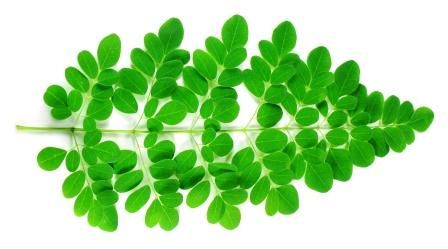
Classical categorization
Charaka Samhita –
Krimighna – A group of herbs that are used to treat worm infestation.
Svedopaga – Ayurvedic plants that are used in Svedana (preparatory procedure for Panchakarma)
Shirovirechanopaga – group of herbs that are used in Nasya Panchakarma treatment
Katuka Skandha – a group of herbs that have a pungent taste.
Charaka has mentioned this as one of the herbs used in powder massage, useful in pruritis, acne and urticaria.(Reference: Charaka Samhita Sutrasthana 3rd chapter)
Charaka has also mentioned it as a plant source for oil – Sthavara Sneha Yoni (Reference)
Sushruta and Vagbhata – Varunadi Group of herbs. (Hence it is an ingredient of a famous Ayurvedic medicine – Varanadi kashayam)
Bh. P . Ni – Guduchyadi varga
Morphology
Habit- Small or Middle sized tree.
Bark- Corky
Wood-Soft
Root-Pungent. Young parts are tomentose
Leaves-Usually tripinnate, rhachis are slender, pinnae and pinnules are opposite. rachides are very slender
Inflorescence- Large puberculous panicles
Flowers-White in colour, calyx lobes are linear, lanceolate, , petals are veined, stamens five and are fertile.
Fruit- Pod, reaching up to 45 cm long and 9 ribbed.
Seeds -Three angled, and the angles are winged
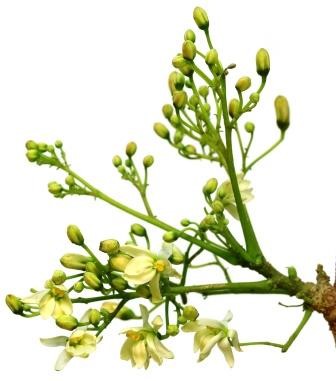
Medicinal Qualities of drumstick tree
Rasa (taste) – Katu (Pungent), Tikta (bitter)
Guna(qualities) – Laghu (light to digest), Rooksha (dryness), Teekshna (strong, piercing)
Vipaka – katu (Moringa undergoes pungent taste conversion after digestion)
Veerya – Ushna – hot potency.
Effect on Tridosha – Balances Kapha and Vata.
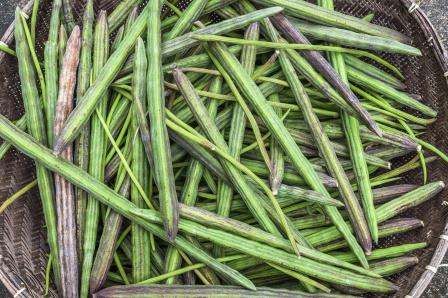
Parts used
Drumsticks root bark, stem bark, leaves, fruits and seeds are used for therapeutic purposes. They have their own unique medicinal qualities.
Dosage
Swarasa (Juice) – 20 – 30 ml
Kwatha (Decoction) – 30 – 50 ml
All values are per 100 grams of edible portion. (Reference)
| Fresh Leaves | Dried Leaves | |
| Arginine | 406.6 mg | 1,325 mg |
| Histidine | 149.8 mg | 613 mg |
| Isoleucine | 299.6 mg | 825 mg |
| Leucine | 492.2 mg | 1,950 mg |
| Lysine | 342.4 mg | 1,325 mg |
| Methionine | 117.7 mg | 350 mg |
| Phenylalinine | 310.3 mg | 1,388 mg |
| Threonine | 117.7 mg | 1,188 mg |
| Tryptophan | 107 mg | 425 mg |
| Valine | 374.5 mg | 1,063 mg |
Vitamins and Minerals
All values are per 100 grams of edible portion.
| Fresh Leaves | Dried Leaves | |
| Carotene (Vit. A)* | 6.78 mg | 18.9 mg |
| Thiamin (B1) | 0.06 mg | 2.64 mg |
| Riboflavin (B2) | 0.05 mg | 20.5 mg |
| Niacin (B3) | 0.8 mg | 8.2 mg |
| Vitamin C | 220 mg | 17.3 mg |
| Calcium | 440 mg | 2,003 mg |
| Calories | 92 cal | 205 cal |
| Carbohydrates | 12.5 g | 38.2 g |
| Copper | 0.07 mg | 0.57 mg |
| Fat | 1.70 g | 2.3 g |
| Fiber | 0.90 g | 19.2 g |
| Iron | 0.85 mg | 28.2 mg |
| Magnesium | 42 mg | 368 mg |
| Phosphorus | 70 mg | 204 mg |
| Potassium | 259 mg | 1,324 mg |
| Protein | 6.70 g | 27.1 g |
| Zinc | 0.16 mg | 3.29 mg |
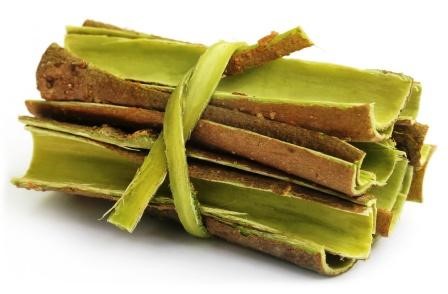
Home remedies
By Dr MS Krishnamurthy MD (Ayu), PhD.
Hypertension
1. Drumstick pod decoction for Hypertension, improper fat metabolism, lethargy, sexual debility:
Daily, 1 drumstick is taken and it is cut into pieces and decoction is made. According to one’s need and acceptance, slight salt may be added. This is taken once daily, preferably during the evening, before food.
This has good benefit in hypertension, hyper cholesterol, improper fat metabolism, lethargy, sexual debility etc
Decoction of any herb is prepared by adding a tablespoon of herb with 2 cups of water, boiling and reducing to half a cup. Filtered and consumed when it is hot. It is also called herbal tea.
Conjunctivitis, swollen eyes
2. Leaf juice in conjunctivitis and swelling of the eyes:
A fistful of leaves is taken and its juice is obtained. This is instilled to both the eyes in the dose of 2 drops.
In cases of swelling around the eyes, this juice is applied around the eyes (paste can also be used for this purpose)
Dysmenorrhea
3. Leaf decoction in dysmenorrhoea, back ache and pimples:
It balances Vata and Kapha Dosha. Leaf decoction of drum stick in the dose of 50-60 ml twice daily is helpful to overcome the back ache and dysmenorrhoea.
Being a blood purifier it pacifies the pimples and black heads.
Anorexia
4. Flower curry or powder in Abdominal distention and tastelessness:
A fistful of moringa flowers are collected and cooked well with salt and black pepper (or garlic and ginger powder /paste).
This is served during lunch as a side dish. This has a very good effect in subsiding gaseous distension of abdomen and anorexia.
Dried flower is fried with little ghee and sprinkled with a little pepper powder and salt. Or it can be made into fine powder and can be kept ready to serve during food. This has good benefits in cases like morning sickness caused during pregnancy and in any other tasteless conditions.
Face pack, soup
5. Leaf paste with lemon juice face pack:
Leaf paste or juice with lemon juice can be mixed and applied over the face. This is useful to overcome black heads and acne.
6. Drumstick Pod soup:
The soup prepared from drumstick pods is very much useful in treating the diseases of liver, spleen, pancreas etc. This is an aphrodisiac also. It strengthens the bones and joints too.
Health benefits of Moringa
There are three varieties of Moringa explained in the Ayurvedic text book Bh. P . Ni
1. Shyama – black variety
2. Shveta – white variety and
3. Rakta – red variety. It is also called Madhu shigru.
Based on the colour of flowers 2 varities – Sweta (Katu sigru) and Rakta (Madhu Sigru) – Moringa concanensis. Sweta sigru is the common variety.
4 varieties are mentioned in Ra. ni – Sighru, Nila Sighru, Sweta sighru, Rakta Sighru
Sanskrit verse
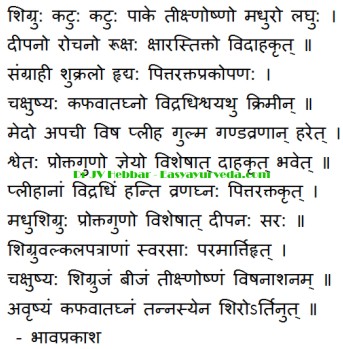
Drumstick – Black variety
Black variety of drumstick tree is the most common. Its qualities are –
Katu – pungent,
Teekshna – piercing, sharp, strong
Ushna – hot in potency
Madhura – slightly sweetish
Laghu – light to digest
Deepana – improves digestion
Rochana – Improves taste
Rooksha – dry
Kshara – Has alkaline properties
Tikta – Bitter
Vidaahakrit – causes burning sensation
Sangrahi – Useful to check diarrhea
Shukrala – Improves semen quantity and sperm count
Hrudya – Good for the heart. Cardiac tonic
Pittarakta prakopana: Increases Pitta and vitiates blood. Hence, drumsticks should not be consumed during bleeding disorders, during menstruation and for people with pimples and Pitta related skin diseases.
Chakshushya – Improves vision, good for eyes.
Kaphavataghna – Decreases imbalanced Kapha and Vata
Vidradhi – Useful in abscess. It helps in quick wound healing of abscess, upon oral intake and external application as paste.
Shvayathu – It is a good anti-inflammatory herb.
Krimi – useful in worm infestation in stomach and in wounds.
Meda – helpful to decrease fat and obesity.
Apachi – Useful in relieving carbuncles.
Visha – Anti toxic. Has detoxifying action.
Pleeha – Useful in spleen related diseases
Gulma – Useful in abdominal bloating and tumors
Ganda Vrana – Useful in lymphadenitis
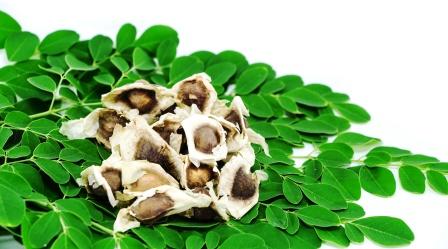
Drumstick – white variety
White variety drumstick uses:
It is quite similar to the black variety.
Dahakrut – causes burning sensation
pleehaanaaM vidradhim hanti – useful in splenic abscess
VraNaghna – helps in quick wound healing
pittaraktakrut – Increases Pitta and vitiates blood.
The red variety, called as Madhushigru
Deepana – Increases digestion power.
Sara – promotes proper bowel movements.
Drumstick leaves and bark
The juice extract of drumstick leaves and bark are very useful in relieving pain. They act as natural analgesics. They are used both for oral intake and also for external application as paste.
In an Indian household, the leaves are used to prepare Chutney or sambar.
The paste of moringa leaves are applied externally to relieve pain and inflammation.
It is applied over pile mass to relieve pain and itching.
Moringa leaves are used internally to improve eyesight, also for the treatment of Ulcerative colitis.
Properties as per Bhojana Kutuhala
According to Bhojana Kutuhalam twelfth chapter, The leaves of shigru when used as a vegetable imparts taste, relieves vata and kapha related disorders. It is pungent in taste, hot in potency, stimulates the digestive fire, wholesome for the body, checks intestinal worms and promotes digestion.
The fruit of white shigru is cold in potency, Is aphrodisiac, slimy in nature, aggravates kapha and is heavy for digestion. It stimulates the digestive fire, alleviates vata and pitta, imparts complexion and treats hemorrhoids and prameha.
The fruits of Red shigru are pungent and sweet in taste, It is unctuous, penetrating in nature, cold and heavy for digestion. It improves clarity of vision, increases production of breast milk, aphrodisiac, nourishing and cleanses the bladder. It treats disorders of medha, gulma, abdominal disorder, dyspnoea, impairment of voice, worm infestation and edema.The root alleviates vatadi doshas, promotes strength, is hot in potency and stimulates the digestive fire.
The flowers of shigru is heavy for digestion, cold in potency, alleviates pitta and kapha dosha and treats intestinal worms, improves clarity of vision, increases the quantity of semen, imparts taste, It nourishes the body, stimulates the digestive fire and loosens the stools.
The oil is pungent in taste, hot in potency, alleviates vata and kapha dosha, is slimy in nature, helps in treating skin diseases, wounds, itching and edema.
Drumstick seeds uses
Chakshushya – good for eyes
Vishanashana – anti toxic
Avrushya – do not have aphrodisiac qualities
Nasyena Shiro Artinut – When used for Nasya (in the form of powder or oil), it helps to relieve headache.
Moringa seeds are called Shweta Maricha.
Moringa for headache
As explained above, moringa leaf paste applied externally, or used as a vegetable helps to relieve headache.
Its seed powder, in the form of nasya treatment, cures headache.
Moringa for diabetes
Many studies have been conducted to prove the anti diabetic and antioxidant effect of Moringa.
Moringa flowers
It is useful in intestinal worms. It balances Pitta and kapha.
Moringa oil
Oil prepared with Moringa is useful to relieve headache, pungent, and useful in skin diseases and diabetes.
Moringa leaves for balanitis
Leaves are ground to make a paste. It is applied over the inflamed area.
Moringa powder
How to consume Moringa powder? What is the best way?
Moringa leaf powder can be readily consumed. In a research study, 100 grams of powder was administered over one week. That is about 15 grams per day. (1). It was for the purpose of testing the iron status of Senegalese lactating women.
However, for a healthy person, Moringa can be consumed in a dose of 3 – 5 grams, once or two times a day, before food.
It can be administered along with water or sesame oil, for Vata balance, along with ghee for Pitta balance and with honey, for Kapha balance.
Moringa powder can also be consumed in the form of decoction. To prepare its water decoction, 1 tablespoon of powder is added to two cups of water, boiled till the water reduces to half a cup and consumed. Here, the dose is half a cup per day. Read rules to prepare Kashayam
Moringa in Ayurvedic medicines
Because of its analgesic effects, Moringa is used as an ingredient in many Ayurvedic pain relief oils such as Murivenna, Kottamchukkadi Thailam,
Because of its anti-inflammatory effects, it is an ingredient of Shothaghna Lepa – a paste application used to relieve swelling, pain and redness.
Because of its wound healing benefits, and usefulness in abscess etc, it is an ingredient in Aragwadhadi kashayam.
Moringa Side Effects
As explained above, it causes an increase in burning sensation and is pungent. Hence, people with gastritis or a sensitive stomach should use this vegetable carefully.
It is not ideal to be taken during periods, since it increases Pitta and vitiates blood.
It is also not ideal to be taken during bleeding disorders.
Interaction with medicines, supplements
Can this be used while taking Homeopathic medicine?
Yes. This product does not react with homeopathic medicine.
Can this medicine be continued while taking supplements like multivitamin tablets, Omega 3 fatty acids etc?
Yes. Generally, this product goes well with most dietary supplements. However, if you are taking more than one product per day, please consult your doctor for an opinion.
With western
medicines
Seek your
doctor’s advice if you are taking this product along with other western
(allopathic / modern) medicines. Some Ayurvedic herbs can interact with modern
medicine.
If both Ayurvedic and allopathic medicines are advised together, then it is
best to take Allopathic medicine first, wait for 30 minutes and then take the
Ayurvedic medicine.
Drumstick during pregnancy and lactation
Drumstick fruit is rich in protein, vitamins, minerals and antioxidants. Hence it can be used during pregnancy. But drumstick leaves, root bark and flowers are not indicated during pregnancy.
It is not ideal to take this soon after delivery. However, a couple of weeks after delivery, this can be used.
Drumstick to increase sperm count
Drumstick fruit is known to improve sperm count and quality.
Drumstick (Moringa) leaf powder was evaluated on male reproductive system of Swiss albino mice Mus musculus. The sperm count, its mobility and mortality, histology of testis and epididymis of normal and hyperglycaemic male Swiss albino mice have been investigated and an attempt has been made to evaluate the efficacy of Moringa leaf powder in repair mechanisms in case of hyperglycemia. In treated mice (Group III), the sperm count significantly increased, sperm mobility also increased but sperm mortality decreased significantly. There was a slight decrease in weight of testis (0.478±0.008gm to 0.33±0.006 gram) respectively when compared to the control mice group. (research)
Moringa seeds for colitis
An experimental study conducted on rats concluded that MSHE (Moringa oleifera seeds hydro-alcoholic extract) and MCF (chloroform fraction ) were both effective to treat experimental colitis and this might be attributed to their similar major components, biophenols and flavonoids. Since the efficacy was evident even in low doses of MSHE, presence of active constituents with high potency in seeds is persuasive. (Source).
Sanskrit Synonyms:
Shobhanjana – Very auspicious tree
Bahumula – Sigru plant has many root
Ghanachada – Plant has dense foliage
Mulakaparni – Leaves have strong qualities like that of radish
Krushnigandha – Odour of shigru is very strong like that of black pepper
Harita saka – Sighru is used as green vegetable
Shigru – has strong, piercing qualities
Teekshnagandha – Strong and pungent odor
Aksheeva – relieves intoxication
Mochaka – helps to cure diseases
Vidradhighna – Sigru is very useful in abscess
Drumstick leaves, raw
Taste – pungent, bitter
Properties – light, dry, sharp, piercing
Potency – hot
After digestion taste transformation ( Vipaka ) – pungent
Effect on Doshas
Vata balancing
Pitta increasing
Kapha balancing (paste is useful in treating balanitis)
Drumstick leaves, cooked, boiled, drained, without salt
Taste – pungent, bitter
Properties – light, dry, sharp, piercing
Potency – hot
After digestion taste transformation ( Vipaka ) – pungent
Effect on Doshas
Vata balancing
Pitta increasing
Kapha balancing
Drumstick leaves, cooked, boiled, drained, with salt
Taste – pungent, bitter, slightly salty
Properties – light, dry, sharp, piercing
Potency – hot
After digestion taste transformation ( Vipaka ) – pungent
Effect on Doshas
Vata balancing
Pitta increasing (salt is also Pittakara)
Kapha balancing
Drumstick pods, raw
Rasa – sweet, bitter
Guna – light (moderate calorie), unctuous
Veerya – cold
Vipaka – sweet
Effect on Doshas
Vata balancing
Pitta balancing (good for hair, skin, blood detoxifier)
Kapha increasing (Shukrakara)
Drumstick pods, cooked, boiled, drained, without salt
Rasa – sweet, bitter
Guna – light (cooked), unctuous
Veerya – cold
Vipaka – sweet
Effect on Doshas
Vata balancing
Pitta balancing (good for hair, skin, blood detoxifier)
Kapha nourishing (cooking makes it less heavier and less Kaphakara)
Drumstick pods, cooked, boiled, drained, with salt
Taste
– sweet, bitter, slightly salty
Properties – light (cooked), unctuous
Potency – not very cold (salt is hot in potency)
After digestion taste transformation ( Vipaka ) – sweet
Effect on Doshas
Vata balancing
Pitta nourishing (cooked drumstick pod is Pitta balancing, but salt is
Pittakara)
Kapha nourishing (cooking makes it less heavier and less Kaphakara)
Distribution
All over India
Sthanika karma (Systemic action)
External application- External application of its leaf and stem bark indicated in oedema, abscess. It can cause burning sensation. Seed powder can be used for Nasya. Seed oil used for oedema and pain.
Nervous System – It has Tikshna (Penetrating), ushna (Hot) property. so stimulate the nervous system. Indicated in weakness of nervous system, Hemiplegia, paraplegia, facial palsy and other degenerative nervous disorders
Digestive system – Being spicy and hot it stimulates taste buds, carminative, absorbent, anthelmintic and analgesic. Madhusighru, has laxative action. Indicated in loss of appetite, abdominal disorders, phantom tumor, abdominal pain
Circulatory System – Stimulate heart, increase blood pressure. Reduce oedema. Indicated in weakness of heart
Respiratory System – Pacify Kapha dosha, Indicated in Cough
Excretory system – Stimulates kidney, increases urine production, causes alkalinity of urine. Not indicated in renal disorders
Reproductive System – Being hot it stimulates menstrual bleeding, Indicated in oligomenorrhea.Satmikarana –Anti poisonous, Reduce sperm count, reduce body fat (Medoroga)
Tapakrama – Indicated in fever (Sweda janana)
Netra – Anjana with its seed is indicated in eye disorders




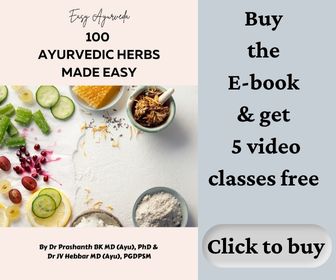




63 comments on “Moringa Benefits, Medicinal Usage, Complete Ayurveda Details”
Dr J V Hebbar MD(Ayu)
Dear Tioma,
it is observed that some of the chemical constituents of Moringa root bark and flowers can cause miscarriage. (Source – WebMD). Hence it is not advised as precaution.
buddha zorba
moringa flowers are boiled with milk as an aphrodisiac ?
Can you please confirm and elaborate ?
Dr J V Hebbar MD(Ayu)
There are many websites claiming aphrodisiac activity. So, it must be true.
I am yet to come across Ayurvedic reference for this.
Jimmy
Hello, Moringa has protein in it. How much is dry leaf in powder form moringa recomended per day. I am 33 year male on vegetarian diet with no health issue. I am trying to figure out in grams. Thank you Sir
Dr J V Hebbar MD(Ayu)
Hi, moringa (drumstick) leaves are commonly used as a vegetable, as similar to any green leafy vegetables. If you want to put a number, I would say, you can use up to 20 grams per day in the form of Sabji, Sambar, chutney, gravy etc
girish
extremely useful
Dahyabhai M. Patel
Very very useful information. Moringa is the best complete food and phytonutrient for ayurvedic use. Dahyabhai M. Patel, Secretary, Amla Growers Association of Gujarat. I am preparing detail power points on Moringa- Agrotechnologies and its Multiple Uses.
Dr J V Hebbar MD(Ayu)
Hi, Horseradish is Armoracia rusticana. It is different from Moringa.
Sue
is Shigru is same thing as Moringa?. If so does Moringa have iodine in it and is high in C also?.
And how much in podwer form do you suggest is ideal for to take?
It’s sold in podwer in western countries.
Sue
Does it aggravate chronic Gastrist ?.is it tridohas herb
Dr Malini Bhat
Dear Madam, The leaves of the plant have known to increase healing of gastric ulcers.
Regarding the effect on Tridosha –It balances Kapha and Vata
Sue
It will not increase pitta?. Does moringa heating qualities if does it not heating things makes ulcer and inflammation etc worse as chronic Gastrist is inflammation of the stomach lining ?.
Isn’t chronic Gastrist or ulcer are due to pitta?.
Dr Malini Bhat
Dear madam, Here is the study that has been done on Moringa leaves. The effect of different extracts of leaves and fruits of Moringa oleifera. Lam. (Moringaceae) on gastric and duodenal ulcers was evaluated by using different gastric ulcer models and cysteamine-induced duodenal ulcer method. The leaf extracts (500 mg/kg, p.o.) of Moringa oleifera. showed gastric ulcer healing effect in acetic acid–induced chronic gastric ulcers. The acetone extract and methanol extract of the leaves produced gastric antisecretory effect in pylorus-ligated rats and showed gastric cytoprotective effect in ethanol-induced and indomethacin-induced gastric ulcers. The leaf extracts also produced a significant reduction of stress-induced gastric ulcers and cysteamine-induced duodenal ulcers. None of the extracts of the fruits showed any significant antiulcer effect. It was concluded that leaves of Moringa oleifera. increase healing of gastric ulcers and also prevent the development of experimentally induced gastric ulcers and duodenal ulcers.
Chronic gastritis or Amla pitta as said in ayurveda, Patients are prone to this if you have a pitta type constitution. Now a days A bacterial infection, helicobacter pylori, is believed to be a major cause of gastritis. When addressing gastritis, many researchers now look for substances that eradicate H. Pylori.
Sue
Can it used for Hashimoto hypothyriod?.
Dr Malini Bhat
Dear Madam, One of the possible trigger of Hashimoto thyroiditis is Iodine nutritional deficiencies so consumption of Shigru is recommended and in lesser amount.
Sue
How much is recommended for Hashimoto as mentioned in small amount how much would be small amount . I can also get capsule form and podwer form.
It’s Hypothyriod with Hashimoto as I have antibodies
Dr Malini Bhat
Dear Madam, Would suggest you to take a advise from a learned Ayurvedic Physician for this as He/she might tell you the exact dosage seeing at your reports . As we are genetically different with different constitutions and patterns, we respond to treatments in many different ways so I would advise to consult a Ayurvedic Physician before taking any medication.
kula
hi dr. hebbar just want to clarify more which part of moringa plant is more effective to induce menstraution is it the root bark or stem bark? Because i read some article and says the root bark maybe dangerous and fatal if taken more than enough. So what should be the dosage if i want to boil root bark and drink?
Dr J V Hebbar MD(Ayu)
Hi, both stem and root barks are useful.
Narendra
What is horse radish called in north indian ayurvedic stores, as well as Moringa.
.
Dr Malini Bhat
Moringa is called Sahijan. One of the common names include Horse radish tree.
Sonali
Dr, is drumstick useful in treatment of ascitis related with liver cirrhosis patients
Paul
Hi
I came to know that dried moringa leafs are very good for hypertension , is it true?
Dr J V Hebbar MD(Ayu)
Hi, as per research articles published here – http://iasir.net/AIJRFANSpapers/AIJRFANS14-309.pdf
the useful part in this case is leaves.
Dr J V Hebbar MD(Ayu)
An experimental study conducted on rats concluded that MSHE (Moringa oleifera seeds hydro-alcoholic extract) and MCF (chloroform fraction ) were both effective to treat experimental colitis and this might be attributed to their similar major components, biophenols and flavonoids. Since the efficacy was evident even in low doses of MSHE, presence of active constituents with high potency in seeds is persuasive. Source – http://www.ncbi.nlm.nih.gov/pmc/articles/PMC4103706/
So, using its seeds regularly in diet is useful in colitis, even ulcerative colitis. Dose – 5 – 10 seeds per day.
rajbinder
dear dr i am56 yrs old female have slurred speech for last three years drs dont know why can you please tell me if moringa will help me if so how to take it and what part
Shiuli goswamu
Is moringa anyway helps in the cure of liver cysts ?
Dr J V Hebbar MD(Ayu)
Not very useful.
Rayyan
Tamil Name to be corrected as – Murungai
Dr J V Hebbar MD(Ayu)
Hi, Thanks. Corrected.
ajay
It’s very great and knowledgeable content.
SF LIM
Hi doctor,
The stick of my moringa is red. It is safe to consume?
Dr J V Hebbar MD(Ayu)
Cooking does not reduce nutrients. Hence, soup, rasam, etc are fine.
if only moringa is not available, only then one can go for dry powder or capsules.
Mohan
Hi Doctor,
Whether it cures Diabetes
Sheela
Hi Dr. Thanks for the valuable information. Couple of questions:
For hypothyroidism, is it ok to consume the leaves daily?
In your article, the dry leaves indicates higher nutritional content. How much of dry leaves powder do I need to take for hypothyroidism?
Thanks so much.
SK
Vijayalakshmi
Murunga according to ayurveda is drying but it is good for vata. I have read that drying stuff is not good for vata. So is drumstick recommended for vata people.
Dr J V Hebbar MD(Ayu)
It can be used even in Vata people along with sesame oil or ghee. These two would nullify the drying effect of Moringa.
anik
can moringa leaves used by distillation extract?
jennie
Moringa leaf is commonly being used to promote lactation. Is this safe? Would consuming this create a detoxification effect of toxins or heavy metals into breastmilk?
Dr J V Hebbar MD(Ayu)
It is safe during lactation.
anik
how much fresh moringa leaves should i take regularly? and which is the best way of taking moringa leaves? thnanks.
Dr J V Hebbar MD(Ayu)
Dry powder – 5 grams per day.
Fresh leaves – 20 grams can be used in preparing Rasam, Sambhar, Chutney etc.
rohit sharma
Can moringo nutromatrix capsules is usefull in skin deseas and asthama
Samir
I am having a glass of moringa water drink every day in the morning in empty stomach for weight loss.
How much moringa leaves should be used to make moringa water drink per person.
Should it be taken with hot or regular water.
Is it safe for kids below 11 years.
Dr J V Hebbar MD(Ayu)
Hi, 10 grams of moringa leaves can be used for making the drink, per day. It can be given with hot water.
Safe for kids for only 1 month time.
Sudha
Does moringa work for anemia, low haeamoglobin count? If so, are moringa leaf powder as effective?
Deepika Thakur
Hi doctor ,
I have had 3 minor strokes. Am on blood thinner. Have hypothyroid. And now been diagnosed with auto immune disease lupus. Can this moringa leaves or powder in any form benefit me in any way ?
Kusum Sreenath
Can moringa powder intake daily, cure ulcerative colitis permanently? What is the dosage to be taken.
Yasmin
Marijuana leaves juice can use for weight loss??
It’s effected??
How much can take??
Dasarathi
Sir, how to make moringa leaves paste? For use on wounds caused by skin allergy.
Khalid Lakdawala
Sir, could you please elaborate what is meant by Moringa Seeds? Is it same that comes out of the long stick or drum stick as it is popularly known.?
Manoj Sadafale
Hello Doctor, My name is Manoj.
drumstick is useful in diabetic ?. Sugar level 230.
Pls confirm.
Dr J V Hebbar MD(Ayu)
It keeps sugar under control
Dr J V Hebbar MD(Ayu)
Only to some extent.
Satyan Namdhari
It is confusing that Moringa is called horseradish tree but horseradish itself is a root vegetable comes from a different tree.
Horseradish appears to be used widely in modern / western medicine.
Are there any benefits, uses, or side effects from horseradish (Armoracia rusticana) which is commonly used as a condiment in food in ayurvedic literature?
Dr J V Hebbar MD(Ayu)
If you type horseradish tree in google, it gives you pictures of Moringa oleifera
Tilak
What are the uses of drumstick dry seeds powder . please let me know. Regards.
Bijay
Sir I had olecranon operations..now my elbow movement is limited..do oringa does any help in my elbow movement..plz
Neetz
Sir,plz share shigru guggulu reference …
Dr J V Hebbar MD(Ayu)
Will try to find out.
Dr RajalakshmiGopalan
Fresh leaves are available almost all through the year. Please advise whether I can dry the leaves under sunlight, make a powder at home and use it.
Dr J V Hebbar MD(Ayu)
You can dry it under sunshade. Not under direct sunlight.
Dr G. SivaRam
Moringa seeds are avrishya (anaphrodisiac). Yet it is a common ingredient in Shukra stambhana formulations like Tulasi seeds.